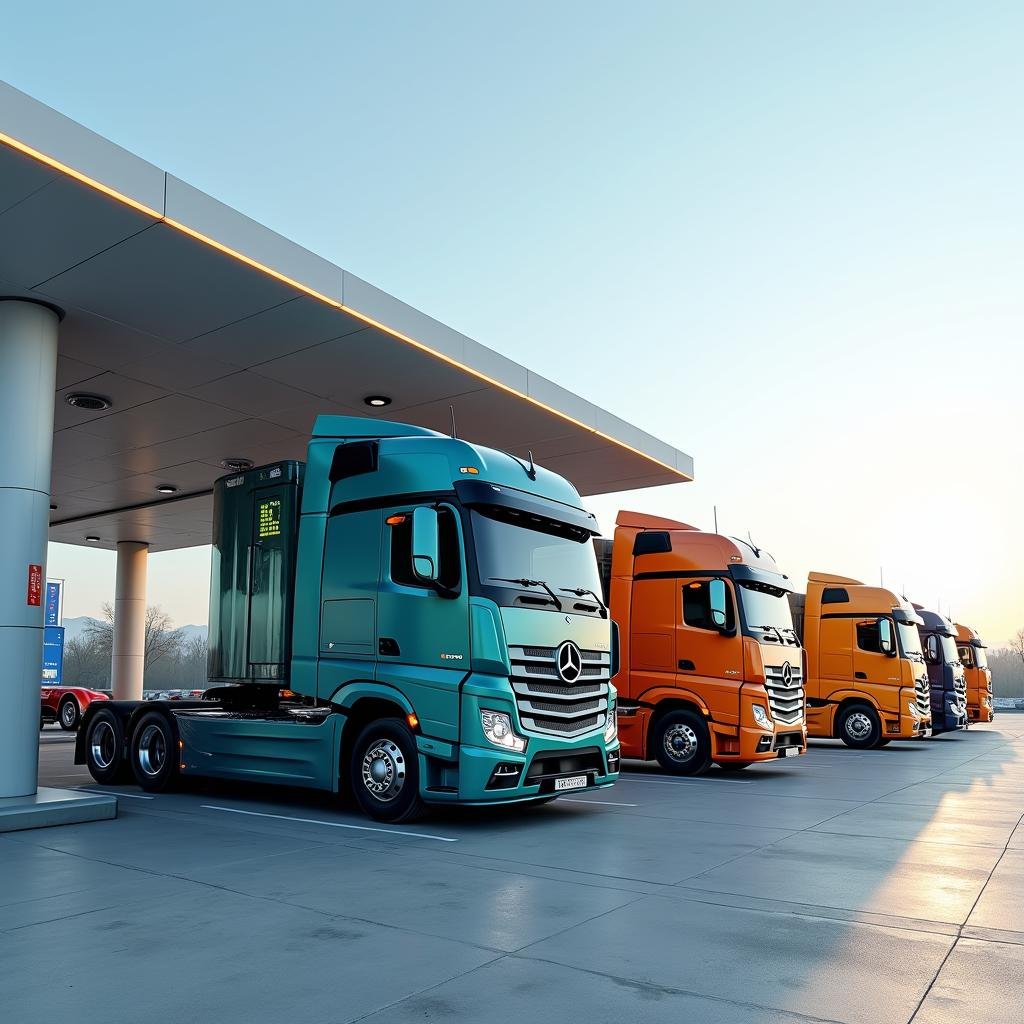In today’s digitally-driven trucking industry, professional drivers are increasingly turning to software for truck drivers to streamline operations, improve efficiency, and enhance road safety. The days of relying solely on paper logbooks and physical maps are long gone. Modern truckers now have access to sophisticated mobile applications and software solutions that can transform every aspect of their work life – from route planning to compliance management.
Whether you’re an owner-operator looking to maximize profits or a company driver aiming to simplify your daily tasks, embracing the right technology can give you a significant competitive edge on the road. The best trucking software applications can help reduce fuel consumption, minimize paperwork, ensure regulatory compliance, and ultimately, improve your bottom line.
In this comprehensive guide, we’ll explore seven revolutionary software tools that are changing the game for truck drivers across North America. These solutions address common challenges in the trucking industry and provide innovative ways to boost productivity and driving performance on long hauls.
The Evolution of Truck Driver Software: From Luxury to Necessity
The trucking industry has witnessed a remarkable technological transformation over the past decade. What was once considered optional technology has now become essential for competitive operations. According to the American Trucking Association, companies that implement digital solutions report up to 30% improvement in operational efficiency.
Today’s software for truck drivers goes beyond basic GPS navigation. Modern solutions integrate multiple functionalities into unified platforms that can handle everything from electronic logging devices (ELDs) compliance to real-time weather alerts and load matching services.
The most significant shift has been the move to mobile-first applications that drivers can access directly from their smartphones or tablets. This accessibility has democratized technology in the industry, making powerful tools available to independent drivers and small fleet operators who previously couldn’t afford enterprise-level solutions.
With the Federal Motor Carrier Safety Administration (FMCSA) mandating electronic logging devices, digital adoption has accelerated throughout the sector, creating an environment where software tools aren’t just helpful—they’re essential for legal operation and business success.
1. Advanced ELD and Hours-of-Service Compliance Software
At the top of our list are Electronic Logging Device (ELD) solutions that help drivers maintain compliance with hours-of-service regulations while minimizing administrative burden.
Features That Matter in ELD Software
- Automated logging: Automatic tracking of driving time, on-duty time, and rest periods
- Violation alerts: Proactive notifications before drivers risk exceeding legal limits
- Inspection modes: Easy access to records during roadside inspections
- Cloud synchronization: Real-time data sharing with dispatch and management
- Intuitive user interfaces: Designed for quick interactions while on the road
Premium ELD applications like KeepTruckin and Samsara have evolved beyond simple compliance tools to offer comprehensive fleet management capabilities. They provide detailed analytics on driving patterns, idle time, and potential areas for improvement in driving habits.
What makes modern ELD software particularly valuable is its integration with other systems. For instance, many solutions now connect directly with transportation management systems (TMS), allowing for seamless data flow between drivers and back-office operations.
When selecting ELD software, drivers should prioritize solutions that offer offline functionality, ensuring that records remain accessible and accurate even in areas with poor cellular coverage—a common challenge on long-haul routes.
2. Route Optimization and Navigation Tools
Generic consumer navigation apps aren’t designed for commercial trucking. Professional truck route planning software takes into account critical factors like vehicle dimensions, weight restrictions, hazardous material routes, and low bridge clearances.
Why Specialized Truck Navigation Matters
Using consumer GPS apps can lead commercial drivers into dangerous situations, including roads with low bridges, tight turns, or weight-restricted bridges. According to transportation safety studies, a significant percentage of bridge strikes involve commercial vehicles following inappropriate routes.
Top-tier truck navigation applications like Trimble CoPilot and TruckMap provide customized routing based on your specific vehicle profile, including height, weight, and cargo type. These tools can save countless hours and thousands of dollars by avoiding costly detours or potential infrastructure damage.
Modern routing software also incorporates real-time traffic data, construction updates, and weather conditions to dynamically adjust recommended routes. The most advanced solutions even calculate fuel-efficient paths based on terrain, helping drivers minimize consumption and reduce operating costs.
Many professional drivers use a combination of tools—a dedicated truck GPS device for primary navigation and mobile apps as backups or for specialized features like fuel price information or parking availability.
Key Features in Truck Navigation Software
- Commercial vehicle restrictions awareness
- Multi-stop route optimization
- Truck-friendly points of interest (rest areas, weigh stations, truck stops)
- Voice-guided navigation for hands-free operation
- Integration with dispatch systems for route updates
3. Load Matching and Freight Finding Applications
For owner-operators and small fleets, finding profitable loads is a constant challenge. Digital load boards and freight matching platforms have revolutionized this process, replacing phone calls and faxes with sophisticated algorithms that connect drivers with available freight.
Software for truck drivers in this category includes popular platforms like DAT TruckersEdge, Truckstop.com, and newer mobile-first solutions like Convoy and Uber Freight. These tools provide access to thousands of loads daily, often with transparent pricing and digital contracting capabilities.
The most innovative freight platforms now incorporate machine learning to match drivers with loads based on their preferences, equipment type, and location patterns. This predictive technology can suggest loads that maximize efficiency by reducing deadhead miles and optimizing routes.
Benefits of Digital Load Matching
- Reduced broker calls: Less time on the phone means more time driving and earning
- Transparent rates: Clear visibility into what loads pay before negotiating
- Location-based matching: Find loads near your current location or desired destination
- Quick payment options: Many platforms offer accelerated payment terms for a small fee
- Broker/shipper ratings: See feedback from other drivers before accepting loads
The most effective drivers often use a combination of traditional relationships and digital platforms to ensure consistent access to profitable freight. By maintaining relationships with trusted brokers while leveraging technology to fill gaps in their schedule, drivers can maximize earning potential and minimize downtime.
According to a DAT Solutions report, drivers who use digital load boards report finding loads up to 75% faster than those relying solely on traditional methods, representing a significant improvement in operational efficiency.
4. Expense Tracking and Business Management Tools
Running a profitable trucking operation requires meticulous financial management. Mobile expense tracking applications designed specifically for truckers help capture receipts, track mileage, and organize tax deductions right from the cab.
Popular trucker expense management software like ATBS TruckersBookkeeping and ExpressTruckTax allow drivers to photograph and categorize receipts instantly, record fuel purchases, and track maintenance expenses. These solutions often integrate with accounting software like QuickBooks to provide comprehensive financial visibility.
Critical Expense Tracking Features
- Digital receipt capture and organization
- Automatic mileage tracking with GPS verification
- Per diem calculation and tracking
- Fuel tax reporting (IFTA) assistance
- Profit and loss reporting by trip or time period
For owner-operators, these tools can be the difference between prosperity and bankruptcy. By providing clear visibility into operating costs and profitability by load, they enable data-driven decisions about which routes and customers truly benefit the bottom line.
The best financial management applications for truckers also provide payment processing capabilities, allowing drivers to invoice customers, track payments, and manage cash flow from their mobile devices. This functionality is particularly valuable for independent operators who handle their own billing.
5. Maintenance and Vehicle Performance Monitoring
Preventive maintenance is far less costly than roadside breakdowns. Modern software for truck drivers includes sophisticated diagnostic and maintenance tracking tools that help prevent expensive failures and maximize vehicle uptime.
Applications like Fleetio and Whip Around enable drivers to conduct digital pre-trip inspections, schedule maintenance based on mileage or engine hours, and receive alerts for upcoming service needs. Many connect directly to engine diagnostic systems through ELD integration, providing real-time performance monitoring.
How Maintenance Software Saves Money
A single roadside breakdown can cost thousands in repairs, towing, and lost revenue. Regular preventive maintenance typically costs a fraction of emergency repairs, and digital tracking ensures nothing falls through the cracks. Industry statistics suggest properly maintained vehicles also achieve 5-10% better fuel economy.
Advanced maintenance applications provide historical service records, parts inventory tracking, and warranty information management. Some even analyze engine performance data to predict potential failures before they occur, allowing for scheduled repairs rather than emergency service.
For drivers operating multiple vehicles or small fleets, these tools provide holistic views of maintenance status across all equipment, making it easier to rotate vehicles for service without disrupting operations. This systematic approach extends vehicle life and preserves resale value.
6. Rest Stop and Parking Finder Applications
Finding safe, legal parking remains one of the most stressful aspects of truck driving. As hours-of-service limits tighten and urban areas become more congested, secure parking has become a premium resource that requires planning and technology to secure.
Specialized parking applications like Trucker Path and Park My Truck provide real-time information about parking availability at truck stops, rest areas, and authorized overnight locations. These tools leverage crowdsourced data from other drivers along with partnerships with major truck stop chains to deliver accurate availability information.
Features That Make Parking Easier
- Real-time availability updates: Know which facilities have open spaces before arriving
- Amenity information: Filter locations by available services (showers, restaurants, etc.)
- Reservation capabilities: Reserve spots at participating locations in advance
- User reviews and ratings: Get insights on safety, cleanliness, and overall quality
- Points of interest: Find nearby services like medical facilities, repair shops, or weigh stations
The most innovative parking solutions now integrate with navigation and hours-of-service applications to suggest parking options based on projected driving time and remaining legal hours. This integration helps drivers plan stops strategically rather than scrambling to find parking as their hours expire.
For drivers in urban areas or high-traffic corridors, these tools have become essential for compliance and safety. By providing visibility into parking options along a route, they reduce stress and dangerous last-minute decisions when seeking rest.
7. Health and Wellness Applications for Drivers
The trucking lifestyle presents unique health challenges, from limited food options to irregular sleep schedules and sedentary periods. A growing segment of software for truck drivers focuses specifically on physical and mental well-being on the road.
Applications like Healthy Trucker and Rolling Strong offer custom fitness programs that can be completed with minimal equipment at rest areas, healthy meal planning with truck stop food options, and sleep tracking to optimize rest quality during breaks.
Why Driver Health Matters
Healthy drivers are safer drivers. According to health studies, well-rested, physically fit drivers experience fewer accidents, have lower insurance premiums, and enjoy longer careers than their less healthy counterparts. With driver shortages continuing to challenge the industry, career longevity has become a priority for companies and independent operators alike.
The most comprehensive health applications incorporate telemedicine services, allowing drivers to consult with healthcare providers from their trucks without losing driving time to clinic visits. This remote access to medical advice helps address minor issues before they become serious enough to sideline a driver.
Mental health support has also become an important component of driver wellness software, with some applications offering stress management techniques, meditation guides, and connection to counseling services. These resources help address the isolation and pressure that can accompany long-haul driving.
Conclusion: Integrating Technology for Maximum Benefit
The seven categories of software for truck drivers we’ve explored represent powerful tools that can transform the driving experience and improve profitability. However, the greatest benefits come when these solutions work together as an integrated technology ecosystem.
The most successful drivers and fleets typically implement multiple complementary solutions that share data and provide comprehensive visibility into operations. For example, when your ELD system communicates with your navigation software, which then integrates with your parking finder app, you create a seamless workflow that reduces stress and maximizes efficiency.
As you evaluate new technology for your trucking operation, consider not just the individual features but how each solution will interact with your existing tools. Look for open APIs and established integration partnerships that indicate a vendor’s commitment to working within the broader technology ecosystem.
The future of trucking belongs to those who embrace digital transformation while maintaining the fundamental skills and work ethic that have always defined great drivers. By leveraging the right software tools for professional truck drivers, you can focus more on driving and less on paperwork, ultimately improving both quality of life and financial outcomes.
Ready to transform your trucking operation with the right technology solutions? Our team specializes in helping drivers and fleet managers identify and implement the perfect software combination for their unique needs. Submit our consultation form today, and we’ll help you navigate the complex world of trucking technology to find the tools that will drive your success for years to come.


